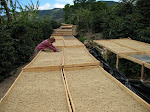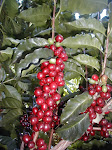Because you need to know more about it. You need to know where it came from, what is being added to it and how to identify the additives.
It is pretty sad but most people don't know much about coffee, while 440 billion cups are drank around the world every year...and that is with most of the Chinese still drinking tea.
So, in my book, an informed, educated person who dares question the coffee establishment is a "snob", so snob is a good title.
Do you want to be one? Hey, keep on reading then.
Be aware that you are going to be fighting very powerful forces. Companies can't help aim for the quick buck. Just imagine how much money a company makes when the low cost fillers are valued at 1/4 of the price of the good stuff? And you could get 90% to 95% fillers in a blend!
Or when a famous coffee brand outsources the production and distribution of the coffee bound for supermarket shelves, but doesn't tell you that it is not the same stuff you have learned to like in their coffee shops.
Good coffee beans are so powerful in their aroma and flavor, and so distinctive in their characteristics that a simple 10% will impact positively any blend.
Long gone are the days when blending was done to search for the ultimate cup of coffee. These days, blend is synonymous with screwed.
Stretching good beans with low cost fillers is a huge business and every company does it; to what degree and with what interest in mind is the big question. And, please, don't get me started with the guys that use 100% of low grade filler beans and put them in a can.
But let's give the bad guys the benefit of the doubt. Let's say they have not realized that you are now learning to appreciate better coffee. That you will soon want to know what fillers have been added to your coffee, where do they come from and in what percentage.
Wouldn't that be fun? The rules would definitely change and that will mean better coffee for you.
So, start questioning:
1. If you see a label that says highland coffee or mountain grown, please call somebody and ask HOW TALL THE MOUNTAIN WAS? This question makes all the difference in the world since the higher the altitude the better the quality of the coffee, and you are expected to pay good money for it.
2. If you see the name of a region in the bag, call the company and ask them what guarantees you have that it is 100% pure and single origin guaranteed. Follow up with a question about percentages of the main ingredient versus the fillers and you will hear a deep silence on the other side of the line.
My rules of thumb:
• Coffee should taste cold as good as it tastes when it is hot.
• In coffee, if the label does not say it, then it is not there. As simple as that.
• The fancier the name, the lower the quality of the coffee; and that includes the evocative names for the roasts, you know, European themes like French, Vienna, etc...or the enticing names for the blends, like "thanksgiving", "Xmas", "breakfas", etc.
There is no industry like coffee to cheat, mislead, omit, forget. Please be aware of that and enjoy your cup.
Saturday, June 13, 2009
Subscribe to:
Post Comments (Atom)





No comments:
Post a Comment
Thank you for your comment...keep them coming.
Best,
Matias